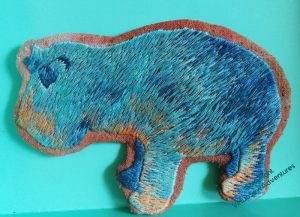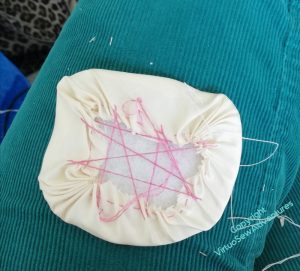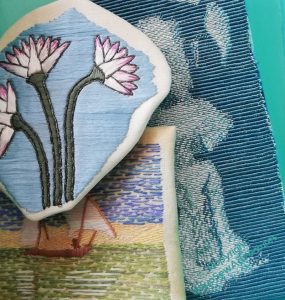Preparing the “Spots”
Once I had some sense that I knew which blocks went where, and what shape I wanted them to be, I could begin to mount them. Some of them will be distinctly tricky, such as the Lotus Tile Fragments, the Nile Tilapia, and (especially), the Faience Hippopotamus.
Since I also picked up a shoulder injury, all this was slowed down by the necessity to do little bits at a time, rather than a whole orgy of concentration.
I worked on the Lotus Tile Fragment while I was stewarding an exhibition that some of my paintings were in. It’s a good idea to have something to do that’s small and easy to put down for that sort of occasion. It’s not a great look to loom at people who’ve come to stroll around, but equally, sitting, hands folded, demure and silent, might also put them off. Looking up with a friendly grin and then returning to something that’s plainly small and interruptible is a useful position between those extremes. ( I sold a painting, too!)
I had a very useful, and suitably faience coloured little box to hand in which all the pieces, so far, have fit rather neatly, keeping them dust-free and untangled.
It’s remarkably satisfying to see them all stacking up, and I have had an idea about details of display in the eventual, hoped-for, exhibition: I could do “record cards” for each piece in the style of something recorded from an excavation, thus providing information, but maintaining the theme.
So now, the question is – what information should I include?




Oh, I love the idea of excavation style record cards! What about looking at some on line for an idea of style and content?
I think you have a good idea there with the record cards. For an exhibition, perhaps a rather less info than a real card. But a little bit about the original piece in the notes, with the technique/style and materials of the embroidery laid out form-style, should benefit both the casual viewer and the embroiderers.
The hippo looks splendid.
If I were to visit your exhibition (oh, how I wish it would be possible) I’d want to read on those cards, both what it is I am looking at and how you have recreated these objects in embroidery.
Every piece looks beautiful, you ARE a great artist.
Congratulations on selling a painting.
Wishing you a speedy recover from your shoulder problem.
I really think the cards are an important element. They give a depth of meaning to the work and ‘lead’ the viewer through the story. Also, they can be used to open your thought process and enhace the visual impact of your work.
Congratulations on your sale and you are so right about having a small project while stewarding. Also gives people and opening to chat to you by asking about your work. The idea of the cards sounds great. xx
That is a GREAT question, what to include. I love that you sold a piece, and as an owner, I’d want more in the provenance than a few facts. I’d want to know about the process, what you’re thinking as you design. Those are the things that help me to really enjoy a painting, a stitchery, or anything artistic. The cards are a great idea, and trying to figure out what to write, even better idea.
Well done on the sale. Great ideas too.